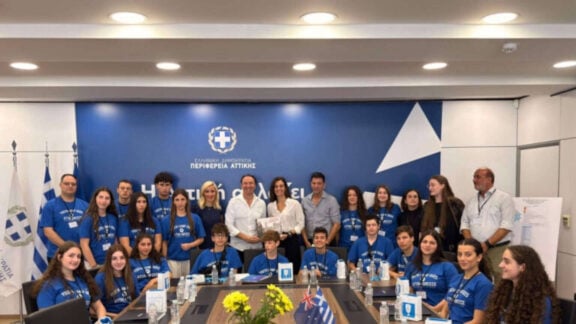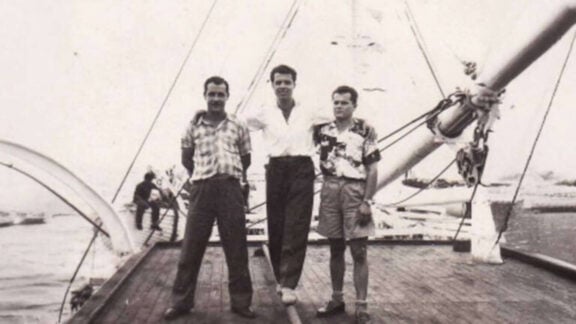It was a pleasure for both myself and Melbourne’s Imvrian Society to bring our Imbros and Gallipoli exhibition to Melbourne’s iconic Greek Centre in late May. This follows its showing at the Greek Festival of Sydney, Brisbane’s Greek Club as well as South Oakleigh College and Oakleigh Grammar. The exhibition was launched in Parkdale last year.
A devoted crowd attended the presentation and launch of the exhibition on a particularly cold and wintry Melbourne night. These included many who have worked to promote awareness of Greece’s history and culture as well as many from the Greek Diasporas who share some of the experiences of those of Imbros. Our important Greek media were represented as well as many of those with Imbrian heritage, including George Xinos, Kaye Lafyati, Gena Asimoglu, Rose Dalama-Martinez, Athan Dolduris, John Brumtis and Con Malathounis. This was the first major event for Melbourne’s Imvrian community at the Greek Centre.

In making my presentation I drew upon my over ten years research into the Hellenic link to the Gallipoli campaign, drawing on the archives in Australia and overseas as well as walking the ground that Anzacs came to over 100 years ago. My interest in the role of the northern Aegean island of Imbros grew out of my research into the role of Lemnos, culminating in my visit to Imbros a few years ago.
My research confirms that Imbros was critical to the conduct of the whole campaign. The Island and its harbours provided an essential military base in close proximity to the battlefields on the Gallipoli Peninsula. It is no wonder that its involvement began in February with the arrival of the Allied fleet – and with the first Australian military commander – at the waters surrounding Imbros. Soon Imbros’ Kephalos Bay – and Aliki Bay on the southern coast – became home to all sorts of Allied shipping including the world’s first purpose-built aircraft carrier.

The shoreline of Kepahlos Bay would be dotted with camps and supply depots, with rest camps and medical services erected and stretching into the nearby valleys. It was here that the Allied Campaign Headquarters were located and it was from here that the terrible battles on the Peninsula and the final successful evacuations would be planned. And it was here that Allied cemeteries would be erected for the Allied dead.
Most importantly Imbros was the vital airbase for the Gallipoli campaign with its many aircraft flying off to support the troops on the Peninsula. The Allied air force based on Imbros would expand until it included all manner of the new technology of the air – from aircraft to seaplanes, to kit balloons tethered to their mother ships to a large hydrogen-filled airship. Imbros brought the air war to Gallipoli.

The Gallipoli campaign brought tens of thousands of Allied soldiers, sailors and airman to Imbros and amongst these were many Australians. Australian soldiers would guard the Allied Headquarters, Australians served in the Allied air force at Imbros. Australian military bakers would supply the troops with fresh loaves of bread to supplement their army rations – 60,000 loaves a day – and Australian troops would come and go from Imbros on their way to and from the front.
It was from Australian journalists based on Imbros that Australians at home heard the stories of the plight of their loved ones at the front. It was here at a small double storey building on the shores of Kephalos Bay – dubbed the Villa Pericles – that the official Australian war correspondent Charles Bean and his staff wrote the accounts of the Gallipoli campaign that were reproduced in newspapers across Australia. It was here that the famous Anzac Book – a bestseller in 1916 – was collated from accounts supplied by the Anzacs themselves.

But most importantly it was on Imbros that many of these young Australian and other Allied soldiers met their local Greek hosts. Ottoman census’ and Australian soldier accounts confirm the overwhelmingly Greek Orthodox nature of the local Imbros population and it was these people who met these young visits from across the world. They interacted with them from their caique boats in the harbour as they offered fresh food for sale and they met them when they came ashore and at the small shop booths the locals set up to cater for the Allied troops. Some locals were engaged to erect the great Allied base on Imbros – from roads and piers, to buildings and the aerodromes.
However they also met them as the Allied troops enjoyed some leave, hiring local donkeys and guides to traverse the Island, experiencing its natural beauty and visiting tis towns and villages. They ate in its taverns, enjoyed a bed in its inns, took part in village celebrations and enjoyed a swim in its clear waters. They saw its ancient ruins, reflective of the ancient history of Imbros, and the Orthodox Churches and chapels that dotted the land.

The Australian and other Allied soldiers experience of Imbros and its people it reflected in their writings, which contain vivid references to the life of the Islanders and their natural environment, as well and in the photographs and artworks they created during their time there. The Australian journalist Philip Schuler would capture an iconic part of Imbros’ history with his photographs of the castle ruins at Castro. Imbros was also the location for the writing of one of the most famous war poems written during the First World War – that written by the British naval officer Patrick Shaw-Stewart entitled Stand With Me Achilles.

I explained how it is this interaction between the Australians and other Allied soldiers with the locals that I find most interesting about the impact of the Gallipoli campaign on Imbros and its people. War is terrible, bringing destruction and death. But it also can bring peoples together and forge new bonds. I is because of these that Imbros lives in the archives of Australia and the United Kingdom, in the street names across Australia bearing reference to the Island and in the hearts and memories of the people of Imbros and the veterans families. In conclusion, I thanked Melbourne’s Imvrian community for their support.

The presentation was followed by a question and answer session. Questions covered some of the personal interactions between the local people and the Anzacs, the Hellenes who served alongside the Allies in the Gallipoli campaign and queries concerning the archives both in Australia and overseas. The audience was amused by the first experiences of yogurt enjoyed by the Allied soldiers on Imbros, their writing on the rural life of the Island, the re-naming of an inn on the Island as the Grand Bretagne Hotel by its enterprising owner during the campaign and much more.
Many questions concerned the life of Imbros today. Concerning the latter my presentation had the privilege of being accompanied by a short video display featuring the photographs of Kate Donnelly/Love the Pen combined with Imbrian traditional songs performed by local musicians of the island, the video put together by the Society’s project officer George Xinos. These beautifully reveal the life of the island today, their colour and sound complementing the black and white photographs from 1915-16 and to an extent bringing them to life.

There was some discussion of how the island’s rich heritage could be greater appreciated, with support for our proposal for an Imbrian Remembrance Trail – much like that which is being slowly created on the nearby island of Lemnos with the involvement of the Australian Government. Given the fact that an estimated 200,000 commemorative visitors go to the Gallipoli peninsula every year and Imbros’ proximity to the Peninsula as well as being accessible by a short ferry ride, there is huge scope for the creation of a commemorative trail linking Imbros’ Gallipoli campaign sites. Such a trail supported by the Australian and Turkish Government’s and local authorities would be great boon to all who call Imbros home.

The presentation on Thursday evening was followed by the display of the full Imbros and Gallipoli Exhibition at the Greek Centre over the following weekend. This was well attended, including by many of the Greek language students and teachers – as well as their parents – present at the Greek Centre. It was also a pleasure to welcome some visitors with Imbros’ connections. Plans are underway for the showing of the Exhibition in Canberra, hopefully Adelaide and at a number of other community locations.

Jim Claven OAM has been researching the Hellenic link to Australia’s Anzac story across both world wars for many years. Secretary of the Lemnos Gallipoli Commemorative Committee, Jim is a trained historian, freelance writer and published author, his most recent works including From Imbros Over the Sea, Grecian Adventure and Lemnos & Gallipoli Revealed. He has assisted in the creation of a number of important memorials including Albert Park’s Lemnos Gallipoli Memorial, Ballarat’s George Treloar Memorial, Lemnos’ Australian Pier Memorial, the Victorian Parliament’s Hellenic Anzac Memorial and the forthcoming Spanish Civil War Memorial in Melbourne. His work on Imbros has been supported by the Imvrian Society of Melbourne and the Victorian Government and Veterans Council. Copies of his books can be purchased at the Greek Centre or by directly contacting Jim at – jimclaven@yahoo.com.au








